A passion for Massey Ferguson tractors
Posted by Chris Graham on 30th November 2023
Chris Graham meets Andrew Drinkwater to learn about his life-long passion for Massey Ferguson tractors, and to spotlight a special model.
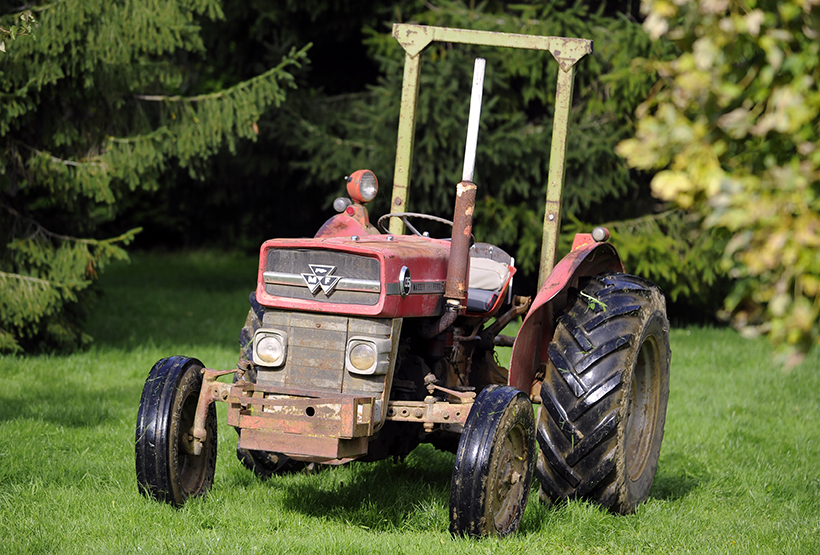
Massey Ferguson tractors: This 1969 MF 135 has been in the Drinkwater family from new and, 54 years later, still starts on the button and continues to work around the farm when needed.
There’s something fundamental about the attachments people develop with the machines they use. Some put it down to simple ’brand loyalty’ but, for others, there’s a more deep-seated sentimentality at play. Whatever the reason, the bond that tractor owners form with their favourite machines is a powerful one that, in many instances, withstands both the march of time and advancements in technology.
Andrew Drinkwater, who is a successful vegetable and fruit grower, has enjoyed a life-long passion for Ferguson and Massey Ferguson machinery. The family farm, in beautiful rural Gloucestershire near Chipping Campden, has run a fleet of MF tractors since he was a boy. “After the war, Dad started growing vegetables, beginning with a single field of sprouts,” he explained to me.

In the early days, the 135 was fitted with canvas-clad Lambourn cab. It provided much needed shelter during the winter months, but was removed in the spring…
“This proved an instant success and the business expanded during the 1950s, with extra land being acquired from Gloucestershire County Council, which enabled a greater variety of vegetables and fruit to be grown. My brothers and I had been actively involved on the farm from an early age so, when we left school, joining the business was something we were very happy to do. To be honest, all I really wanted to do was earn a living driving tractors!”
Earliest memories
“Right at the beginning, Dad started with a Trusty tractor,” Andrew explained, “produced by Tractors (London) Ltd, in Barnet, although I don’t remember that machine. However, I now have a couple of them in my collection, just for old time’s sake. But my first tractor memories are of the grey Fergies that replaced the Trusty. I don’t think that Dad ever bought them new in those days; there were always plenty of used machines available. We’re close to the Vale of Evesham and the vegetable producers in that area used TE-20s by the hundred, so there was never a shortage of good secondhand ones being sold.
“He then progressed to an MF 35 which, in time, was part-exchanged for a brand new 135 Multi-Power, square-winged 1967 model. After that, and with the business continuing to prosper, he bought another new 135, this time a non-Multi-Power, 1969 model, and that’s the one we still have and use now. Back in the day, both the 135s were fitted with Lambourn cabs and, interestingly, we found that the standard model used to pull much more strongly than the Multi-Power version. They were both used for hauling spuds from the fields in three-tonne Fergie trailers, and there was a very obvious performance difference between the two of them.”
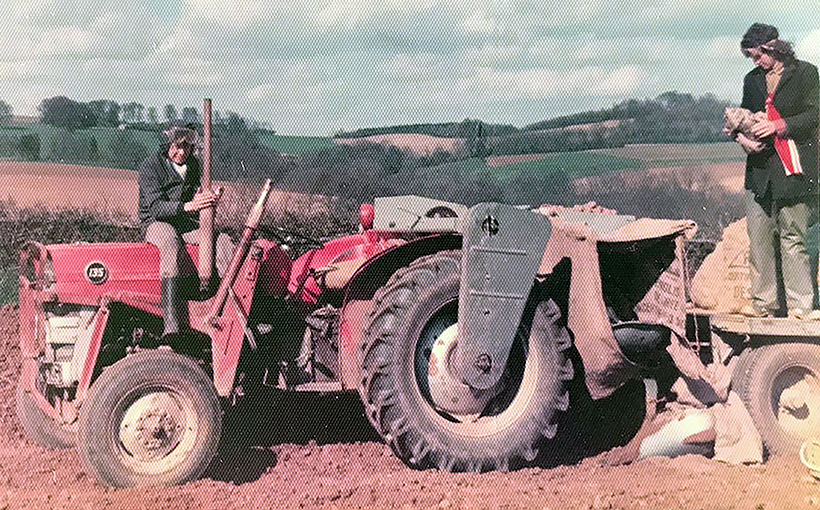
… so that the tractor could be equipped with a Ferguson fertiliser attachment. This unit fitted across the tops of the mudguards, and took its drive from a rear wheel-mounted, bolt-on sprocket.
Other tractors followed as the operation continued to develop, including a couple of MF 165s (one of which was a 1970 Multi-Power model), and then an MF 575. But, as Andrew recalls: “It was always the 1969 MF 135 that was Dad’s favourite and, as a result, it never got moved on. All the others came and went, but that standard 135 outlasted them all. He had a real soft-spot for it right from the start, which is the reason it survived.”
Fully-loaded
“For a good many years, the 135 was fitted with a Mil front loader, which greatly increased its versatility. During the 1970s we used to spread a material called ‘shoddy’ on our fields, then plough it in. It was a waste product from the textile industry that was supplied in large bales; the thinking then was that it represented a cost-effective way of adding fibrous matter to the soil. The loader was used to manoeuvre the 5cwt shoddy bales into a standard Massey Ferguson muck spreader, which then delivered the material to the fields. The Mil loader also proved ideal for handling the large, Kennet potato boxes we were using at that time, as it was fitted with a box-tipping attachment.

Andrew’s brother, Pete, at the controls of the 135 sometime during the late-1990s, harvesting cabbages in a muddy field.
“I remember that 1975 and ’76 were fantastic years for potato producers, with the dry summers pushing prices right up. We paid £4,000 for a new 165 in ’75 and, with spuds selling for up to £200 a ton that season, we needed just 20 tonnes to pay for the new machine outright. The same happened in 1976, which is when we swapped an older MF 65 for a brand new MF 575. I still have fond memories of driving that tractor for the first time, and thinking how amazingly good it was. It seemed like an incredible improvement over the 65; so much quieter and more comfortable, and a real luxury to be insulated from all the dust. I didn’t think that things could get any better than that!
“After that we bought an MF 550, which I then used as my spraying tractor for many years. It was running on hi-clearance wheels and served us well, but the weakness of the 500 Series models was always the cab, which was prone to corrosion. Overall, though, I don’t think that the 550 was ever as good as a 135. The drum brakes on the newer model were a real let-down; I think they were taken straight off the 148 but, because the 550 was a heavier machine, they were never up to the job. Everything is just more balanced on the 135, making it a perfect working machine.”
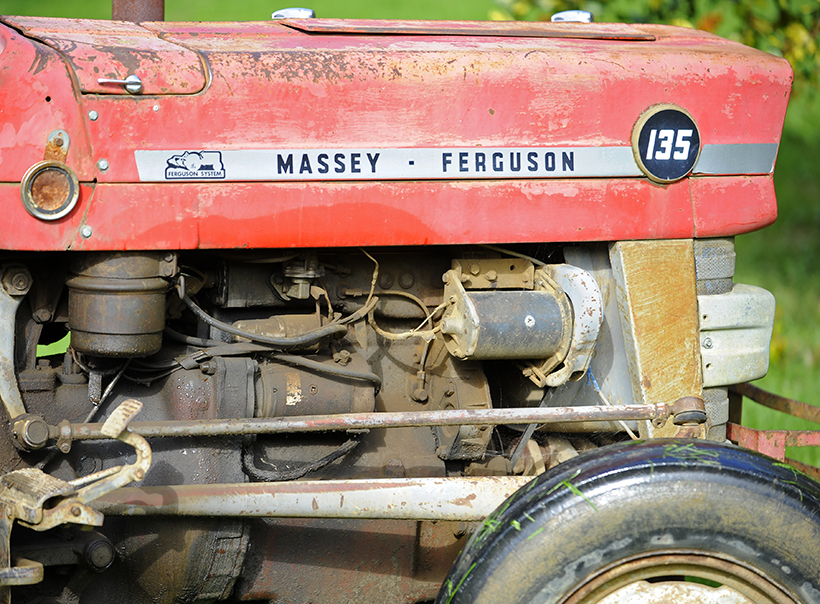
Apart from a recent head gasket change, three clutches (due to the Mil front loader) and routine servicing, this engine has worked faultlessly for more than five decades.
Heavy use
Andrew told me that the front loader was taken off the 135 in the mid-1980s because, without power steering fitted, it was hard work to use. In addition, the heavy work also caused it to burn through three clutches. Apart from that, though, it never gave any problems. “Amazingly, the engine had literally never seen a spanner until last year, when the head gasket had to be replaced; a pretty impressive record for a 54-year-old hard-working engine.
“We used to take care of the routine servicing on all of our frontline tractors here on the farm, replacing the oil and filters at the required intervals and, most of the time, all the machines were kept under cover. I’m not sure of the total number of hours on the 135 because the rev counter packed up years ago, but I’d estimate that it’s run for at least 10,000 since new. Despite its age and lengthy working life, it always starts on the button even after being left outside on the coldest of nights. It’s just a brilliant tractor!” Andrew added.
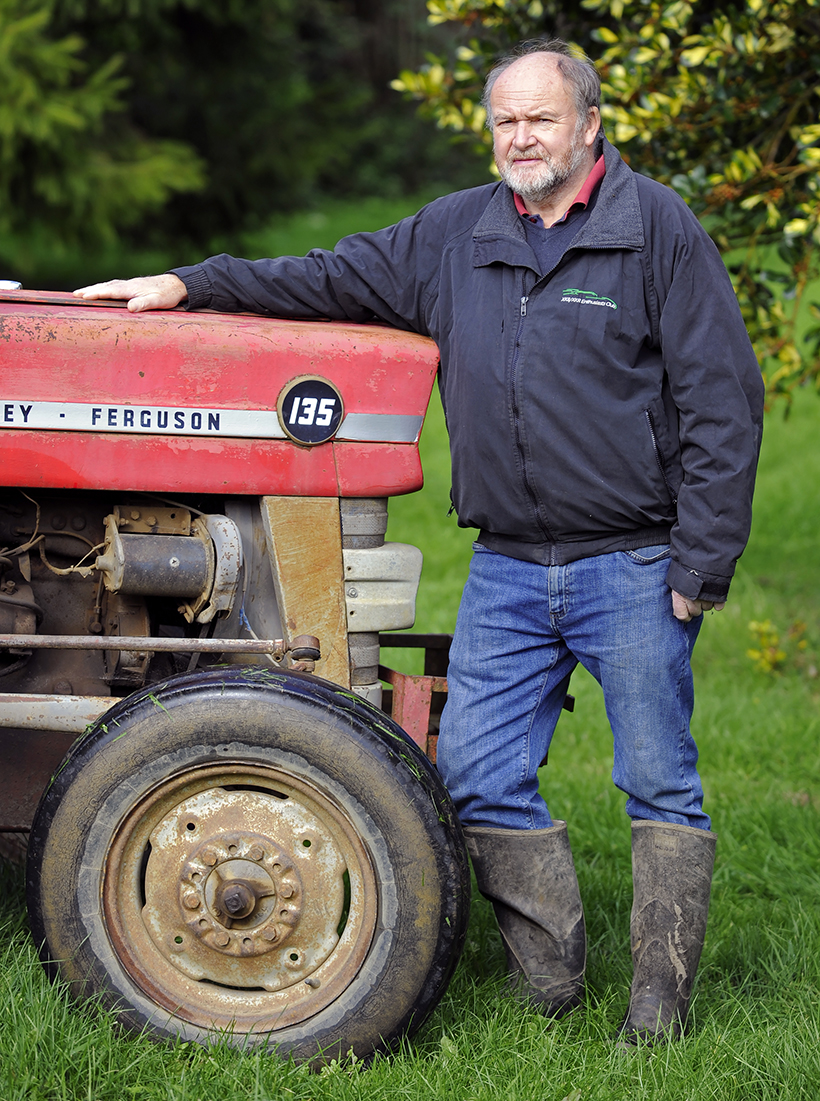
Andrew has known and appreciated this MF 135 since he was a youngster. It was his dad’s favourite tractor, and continues to be held in very high regard now.
Nowadays, of course, the 135 leads a slightly more relaxed life, although it still works on the farm when needed. “Typically during the summer months when we’re out planting, it’ll be pulling a trailer,” Andrew said, “and we also use it with a topper for grass-cutting duties. All of that’s pretty light work, though, as we have bigger, newer and more powerful machines (mostly Massey Ferguson) for handling the heavy work these days. We get on OK with the new MF machines, although some have suffered with a few niggling electrical issues.”
Future plans
As far as the 135’s future is concerned, it certainly won’t be leaving the farm’s ownership, and it’s also unlikely to be receiving any restoration-type attention. “Both my bother – Pete – and I are very much in favour of keeping old tractors as original as possible and, as such, we don’t like to see over-restored examples,” Andrew explained. “There are lots of owners these days who seem only too happy to sweep away all the history of their machines by re-painting everything in glossy two-pack. We certainly don’t agree with that, and can see no point in rebuilding a tractor to a condition that far exceeds the standards set at the factory.
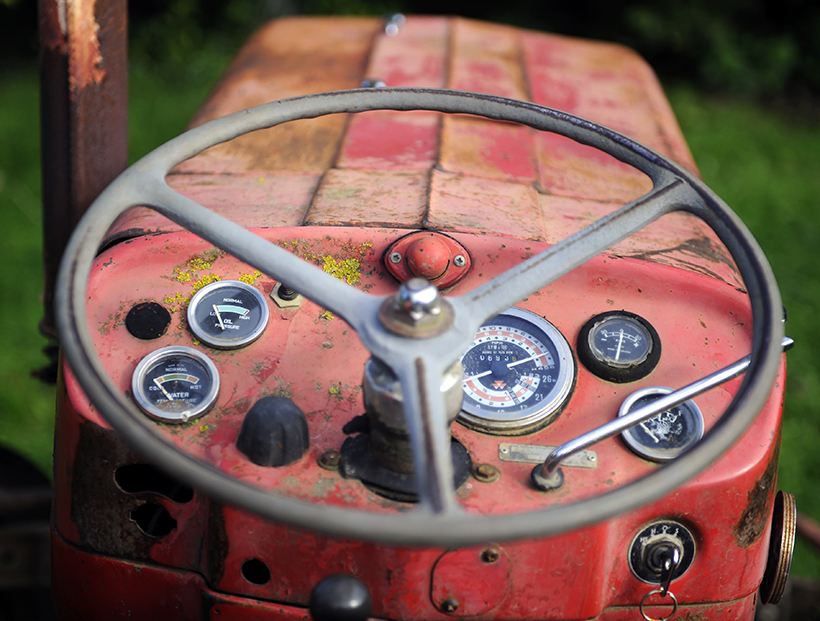
Although showing its age, the 135’s tinwork is all remarkably solid. Zero contact with acidic slurry and regular storage under cover are no doubt factors in this impressive longevity.
“The other point, of course, is that we like to continue using our tractors on a regular basis, and we’d be far less inclined to do that if we were forever worrying about the risk of scratches and knocks. I’m very keen on match ploughing and typically enter several competitions a year, and competing with a pristine-looking tractor would be very counter-productive. Between us, Pete and I probably own at least 60 tractors, although I’m not sure of the exact figure. I always tell people that if you know how many you’ve got, you haven’t got enough!”
Andrew has been ploughing competitively for about 20 years, and he takes it pretty seriously. “I find the whole process extremely relaxing, despite the competitive aspect and the fact that standards have risen a lot in recent times,” he explained. “These days I use a TS82 reversible plough on the back of my MF 165, in the classic reversible plough class. But I also still compete in the Fergie class, with a P3-powered tractor pulling a two-furrow general purpose plough.
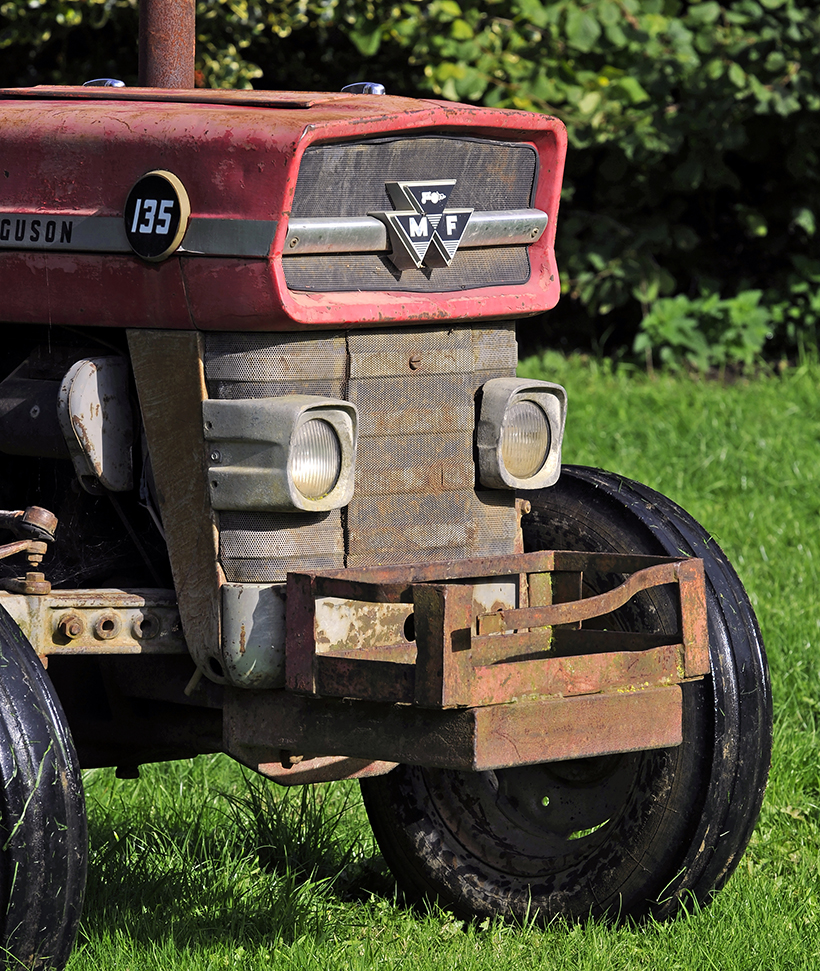
Andrew remembers fabricating this home-made front weight cage when he was in his teens. Like the rest of the tractor, it’s stood the test of time well.
“When I started in the Ferguson class back in the early 2000s, I’d say that the general standard was pretty low. There were always one or two decent ploughmen, but most entering tended to be inexperienced beginners. Now, though, that’s all changed. There are plenty of very accomplished competitors involved these days and everything’s a lot more serious as a result. I’m happy to travel all over the place to compete and, although I missed the Nationals this year due to poor health, I’ve been a regular in that competition for many years.”
Lifelong interest
Chatting with Andrew about the state of the old tractor hobby now, he made some interesting observations. “Our generation was brought up surrounded by agriculture, but I really think that sort of upbringing is rare nowadays. Farms just don’t have enough people working on them any more, which is a real shame. As a result, there aren’t enough youngsters getting involved with tractors; you can see that just by visiting any show. I enjoy tractor road runs, and try to be involved with several every year. But I’ve noticed that young drivers seem increasingly reluctant to take part unless they can drive a modern, 250hp machine with the radio blaring, their girlfriend on the seat beside them and the cab’s the air-conditioning on full!

The roll bar was added in the mid-1970s, when regulations demanded its fitting. As far as Andrew is concerned, the MF 135 is just about the perfect tractor.
“I appreciate that it’s important to attract youngsters into the hobby, but I think there are issues surrounding the relevance of these modern machines, with speed differentials and their size being prime among them. On runs I’ve been on, these powerful giants typically hare off from the start at anything up to 40kph, but then cause a jam in the first village they come to when they’re unable to get through between badly parked cars. Even overhanging trees can be an issue, with the drivers unwilling to push through for fear of damaging a mirror or roof light. Now, I may be slower on our trusty old 135, but the tractor’s manageable size means that it’ll go anywhere and negotiate any obstacle without a problem.
“I’m not sure what the answer is, apart from staggering the start so that all the vintage and classic machines go first, and the modern machinery follows on behind. In some regards, I do worry about the future of the hobby without the influx of young blood it needs. In addition, there seems to be a bit of a move away from the oldest models, with an increasing number of would-be owners rejecting anything with a starting handle as being too much trouble to bother with. That’s just a real shame, as far as I’m concerned.“
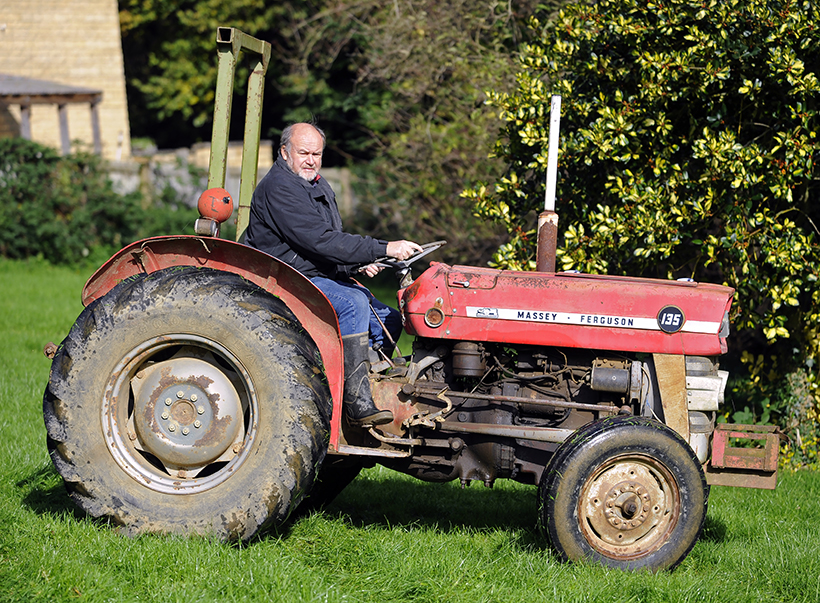
Andrew is a keen member of the Warwick Vintage Tractor & Machinery Club, The Ferguson Club and The Friends of Ferguson Heritage club. He’s also an accomplished ploughman and a regular on tractor road runs… all of which he finds very therapeutic.
Andrew’s right, of course, and there are worrying times ahead if the hoped-for injection of new enthusiasts fails to materialise. There’s no question that you only have to spend a few minutes at any major tractor event to confirm that there’s lots of grey hair around. So I think we all have a responsibility to do as much as we can to fire the enthusiasm of the younger generation by emphasising the fun and affordability that this amazing hobby has to offer.
This feature comes from the latest issue of Classic Massey & Ferguson Enthusiast, and you can get a money-saving subscription to this magazine simply by clicking HERE

Previous Post
Great new diecast and resin models to collect!
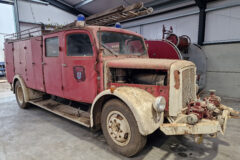
Next Post
BARTON FAMILY (SEABEA TRANSPORT) AUCTION



